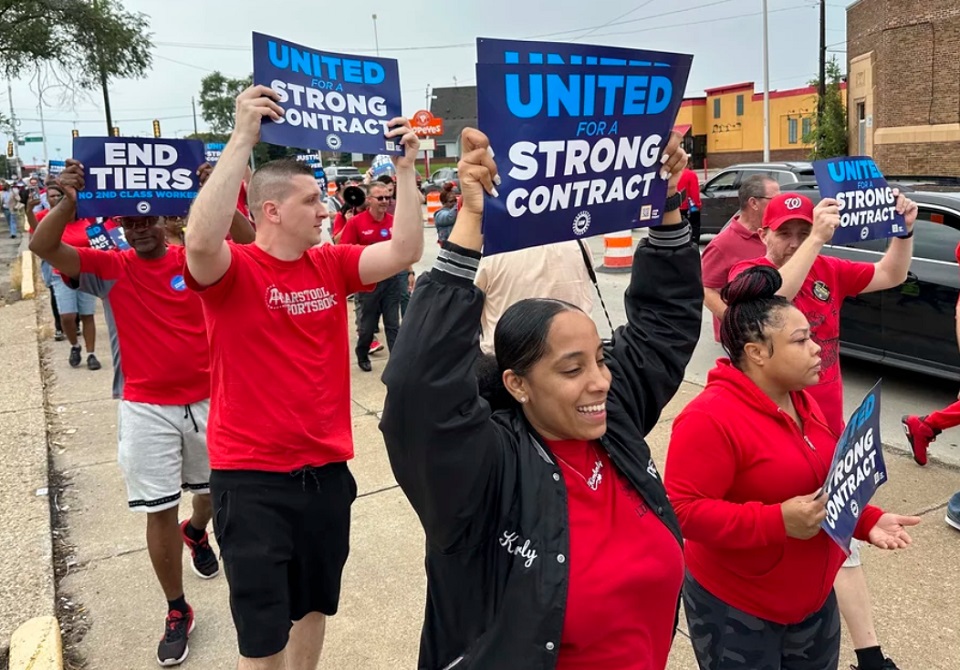
DETROIT —With under a week to go before the Auto Workers’ contracts with the Detroit 3 expire, the union and the companies finally got around to talking numbers.
But news reports, in Detroit media, Yahoo, Reuters and the Associated Press, made it clear there’s still a wide chasm between UAW demands for the 150,000 workers combined who toil at GM, Ford and Stellantis—known as FiatChrysler—and what the companies offered.
“The clock is ticking. Stop wasting our members’ time,” union President Shawn Fain wrote to GM honchos after they directly released an “insulting” pay offer to his members.
The head-to-head comments, even if they’re over monetary issues, increase the possibility the UAW, which has overwhelmingly voted to have new union President Fain and his new reform-slate board authorize a strike, will walk when the clock hits midnight on the night of Sept. 14-15.
And the workers will walk, Fain said, against any or all of the Detroit 3 that hasn’t settled by that witching hour.
The talks between the UAW and the Detroit 3 are important for several reasons. Though wages and benefits are the top issues, they’re not the only ones.
But now that the car firms are flush with billions in profits used for stock buybacks, CEO pay and corporate bonuses, the union—reflecting the militancy which elected Fain—is determined to economically gain back what it’s lost in pay, pensions, cost-of-living raises and health care since the 2008 financier-caused crash forced GM and FiatChrysler into bankruptcy.
Looming over the financial issues, including abolition of the hated two-tier wage system, is how to handle the transition to electric vehicles (EVs) in a clean-energy economy.
The EV transition is thorny for two reasons. One is easy to describe: Making an EV and particularly its motor, battery and drive train, takes a lot fewer workers per car than making an internal-combustion-engine-powered truck, car, van, Jeep, pickup or SUV.
And the companies want to further save money by not only shedding older workers but by keeping the remaining EV parts plant workers—especially at battery plants—on a lower pay scale than assembly line workers at main auto factories.
It doesn’t help matters either that the first two federal EV plant loans, worth $9.2 billion, went to planned plants in anti-union Kentucky and Tennessee and not pro-union Michigan.
With all that, here were some of the week’s developments:
In an Associated Press interview, Fain, who had handled bargaining as a local officer for his home Stellantis plant in Indiana, conceded the union wouldn’t get everything it sought.
A lot of back and forth
“There’s a lot of back and forth in bargaining. And naturally, when you go into bargaining, you don’t always get everything you demand. Our workers have high expectations. We made a lot of sacrifices going back to the economic recession,” he said.
Fain remained as adamant as his members that after years of two-tier wages and with starting pay now for full-timers lower in actual dollars than it was in 2008, the tiers must go and the workers must receive a 40%-46% raise over four years to let them regain what they lost in the last 15 years.
Pay isn’t the only loss UAW seeks to regain. Yearly cost-of-living increases were completely eliminated as a condition of federal loan guarantees in 2009, when the feds brought GM and FiatChrysler out of the bankruptcy they had to declare after the 2008 financier-caused crash. And there are no pensions for new hires since then, either.
The UAW members want the pensions—not 401(k)s—back, and the COLAs, too.
GM and Ford were far from satisfying the UAW. Ford, the first to put something on the table, offered 9% over four years, retained two tiers, and added several bonuses. And while talks were going on it moved up a scheduled year-end $4.33 hourly pay raise for 8,000 UAW-represented workers to appear in the last paychecks just before the current contract expired.
Ford’s “wage proposals not only fail to meet our needs, it insults our very worth,” Fain responded.
UAW’s filing of labor law-breaking complaints against Stellantis and GM for failing to bargain in good faith—its first such filing during bargaining since 1998—forced GM to put its offer on the table, too.
GM offered a 10% raise over four years, two 3% one-time lump payments, a $6,000 inflation payment, $5,000 more to cover inflation during the four years, and a $5,000 per worker contract ratification bonus. There would be no COLAs. It was silent on pensions.
Fain called GM’s proposal “an insult to workers” and noted the firm offered it only after the union filed the unfair labor practices complaint with the National Labor Relations Board. “It doesn’t come close to an equitable agreement,” he said of the company’s terms.
“GM either doesn’t care or isn’t listening when we say we need economic justice at GM,” Fain wrote back after GM sent its offer in a letter to all workers. “The clock is ticking. Stop wasting our members’ time.”
>>> READ MORE PEOPLE’S WORLD COVERAGE OF THE UAW STRIKE.
We hope you appreciated this article. At People’s World, we believe news and information should be free and accessible to all, but we need your help. Our journalism is free of corporate influence and paywalls because we are totally reader-supported. Only you, our readers and supporters, make this possible. If you enjoy reading People’s World and the stories we bring you, please support our work by donating or becoming a monthly sustainer today. Thank you!










